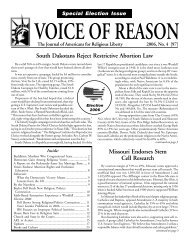The Importance of Church-State Separation - Americans for ...
The Importance of Church-State Separation - Americans for ...
The Importance of Church-State Separation - Americans for ...
Create successful ePaper yourself
Turn your PDF publications into a flip-book with our unique Google optimized e-Paper software.
2<br />
tion between these two powerful <strong>for</strong>ces. Some Islamic and even some<br />
Christian fundamentalists insist today that there should be no separation.<br />
While in Western history, <strong>of</strong> which the United <strong>State</strong>s is a product,<br />
religion and government came to be distinguished or distinguishable in<br />
theory, in actual fact they were/are linked in a variety <strong>of</strong> ways and to<br />
varying degrees.<br />
For example, some Western countries provide tax support to religious<br />
schools; some still have established churches (in the United Kingdom<br />
the monarch is titular head <strong>of</strong> the <strong>Church</strong> <strong>of</strong> England, a fact that<br />
resulted in the curious anomaly <strong>of</strong> the governor <strong>of</strong> Maryland enjoying<br />
the same titular status, even when the governor was Jewish); some still<br />
have compulsory or semicompulsory church taxes.<br />
Established churches were the rule when the first Europeans –<br />
British, French, Dutch, German, Swedish, and even Jewish – settled<br />
the east coast <strong>of</strong> North America. Although many <strong>of</strong> these Europeans<br />
came to America <strong>for</strong> freedom <strong>of</strong> religion, they brought the European<br />
established church tradition with them. By the end <strong>of</strong> the seventeenth<br />
century, the Anglican (Episcopal) <strong>Church</strong> was established in all colonies<br />
from Maryland to Georgia, while Puritan Congregationalism was<br />
established in all the New England colonies except Rhode Island.<br />
By the start <strong>of</strong> the American Revolution, the colonies had become<br />
fairly pluralistic and included Anglicans, Congregationalists, Roman<br />
Catholics, Baptists, Methodists, Presbyterians, Lutherans, Quakers,<br />
Unitarians, and Jews. This pluralism set the stage <strong>for</strong> the development<br />
<strong>of</strong> church-state separation. <strong>The</strong> idea was first articulated by Roger<br />
Williams, the Rhode Island maverick, who seems to have influenced<br />
John Locke, and finally flowered under Thomas Jefferson and James<br />
Madison in Virginia during and immediately after the Revolution. By<br />
1786, thanks in part to Madison’s brilliant 1785 pamphlet, Memorial<br />
and Remonstrance against Religious Assessments, 1 the church-state<br />
separation principle become law in Virginia, setting the pattern that the<br />
other states would sooner or later follow.<br />
In 1787, the United <strong>State</strong>s Constitution created the country’s present<br />
<strong>for</strong>m <strong>of</strong> government. Significantly, it implies the principle <strong>of</strong> churchstate<br />
separation by granting to the national government no authority<br />
whatever to meddle with religion. Indeed, the only mentions <strong>of</strong> religion<br />
are in Article VI, prohibiting religious tests <strong>for</strong> public <strong>of</strong>fice and mandatory<br />
oaths <strong>of</strong> <strong>of</strong>fice.<br />
<strong>The</strong> new Constitution would be ratified, but only after Madison and<br />
politicians in Virginia and elsewhere promised to add a Bill <strong>of</strong> Rights to



